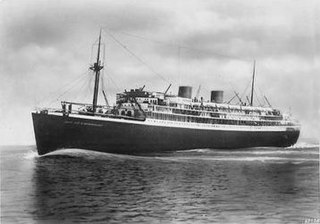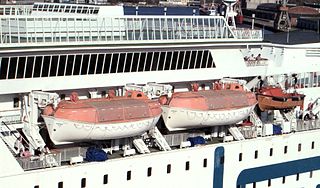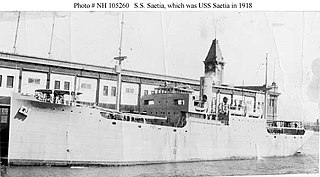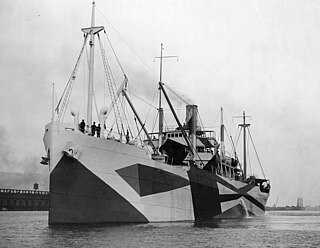
TSMS Lakonia was an ocean liner that was launched in 1929 for Netherland Line as the ocean liner Johan van Oldenbarnevelt. In 1962 she became the Greek Line cruise ship TSMS Lakonia. On 22 December 1963 she caught fire at sea and on 29 December she sank. 128 people were killed in the disaster.

The Lexington was a paddlewheel steamboat operating along the Northeastern coast of the United States from 1835 to 1840. Commissioned by Cornelius Vanderbilt, it was one of the fastest and most luxurious steamers in operation.

USS Starlight (AP-175) was a United States Navy Storm King-class auxiliary transport in commission from 1944 to 1945. She was designed as a troop carrier. After her naval service she became the civilian cargo ship SS Badger State. She sank in January 1970 after an explosion of a cargo of munitions on December 26, 1969, with the loss of 26 of her crew of 40.

SS Alexander Macomb was a Liberty ship built in the United States during World War II. She was named after Alexander Macomb, the Commanding General of the United States Army from May 29, 1828, until his death on June 25, 1841. Macomb was the field commander at the Battle of Plattsburgh, during the War of 1812, and after the stunning victory, was lauded with praise and styled "The Hero of Plattsburgh" by some of the American press. He was promoted to Major General for his conduct, receiving both the Thanks of Congress and a Congressional Gold Medal.
Vorwärts was a wolfpack of German U-boats that operated from 25 August to 26 September 1942, in the Battle of the Atlantic during World War II. They attacked several convoys, principally Convoy ON 127, sailing from Liverpool to New York, and sank fifteen ships for a total of 79,331 gross register tons (GRT), and damaged nine (81,141 GRT).

The SS James B. Stephens was a 7,176-ton American liberty ship in World War II. She was built by the Oregon Shipbuilding Corporation of Portland, Oregon in 1942 with the hull number 580, and operated by United States Lines, New York City and homeported in Portland. For her role of sailing in dangerous waters, she was armed with one 5in, one 3in and four 20mm guns. She was named for the founder of East Portland.

A lifeboat or liferaft is a small, rigid or inflatable boat carried for emergency evacuation in the event of a disaster aboard a ship. Lifeboat drills are required by law on larger commercial ships. Rafts (liferafts) are also used. In the military, a lifeboat may double as a whaleboat, dinghy, or gig. The ship's tenders of cruise ships often double as lifeboats. Recreational sailors usually carry inflatable liferafts, though a few prefer small proactive lifeboats that are harder to sink and can be sailed to safety.

USS West Gate (ID-3216) was a cargo ship for the United States Navy during World War I. The ship was laid down as SS War Agate, but she was launched in January 1918 as SS West Gate instead.
William Brown was an American ship that sank in 1841, taking with her 31 passengers. The survivors took to two boats, which later separated to increase their chances of being found. Nine crewmen and 32 passengers occupied the overloaded longboat. At the instigation of the first mate, who was placed in charge by the captain, some of the crew, Alexander Holmes among them, forced 12 of the adult male passengers out of the boat. In the case of United States v. Holmes, Holmes – the only crewman who could be found – was charged with murder and convicted of manslaughter for his actions.
MV C.O. Stillman was an oil tanker that was built by a German shipyard in 1928 for a Canadian-based shipping company. A Panamanian subsidiary of Esso bought her at the end of 1936 and she was sunk by the German submarine U-68 in the Caribbean on June 4, 1942 about 41 nautical miles (76 km) southwest of Isla de Mona, Puerto Rico.

SS Arctic, an American paddle steamer owned by the Collins Line, sank on September 27, 1854, 50 miles (80 km) off the coast of Newfoundland after a collision with SS Vesta, a much smaller French vessel. Passenger and crew lists indicate that there were probably more than 400 on board; of these, only 88 survived, most of whom were members of the crew. All the women and children on board perished.
SS Fort Mercer was a Type T2-SE-A1 tanker built by Sun Shipbuilding & Drydock Co., at Chester, Pennsylvania in October 1945. SS Fort Mercer, was built under a Maritime Commission contract and launched on October 2, 1945. With World War II ending on August 15, 1945, Fort Mercer did not serve in the war. Fort Mercer was owned and operated by the Trinidad Corporation of New York.
I-37, originally numbered I-49, was a Japanese Type B1 submarine in service with the Imperial Japanese Navy during World War II. Commissioned in 1943, she made three war patrols, all in the Indian Ocean, during the last of which her crew committed war crimes by massacring the survivors of the merchant ships she sank. Subsequently, converted into a kaiten manned suicide attack torpedo carrier, she was sunk during her first kaiten mission in 1944.

USS Saetia (ID-2317) was a United States Navy cargo ship in commission in 1918 that was sunk during World War I.

USS St. Francis (ID-1557) was a cargo steamship. She was built in Ireland in 1914 as San Francisco, and renamed St. Francis in 1918 when she was commissioned into the United States Navy. In 1933 she was renamed Lammot du Pont. In 1942 she was sunk by a U-boat, and 19 of her crew were lost.
SS Thomas Ruffin was a Liberty ship built in the United States during World War II. She was named after Thomas Ruffin, an American jurist and Justice of the North Carolina Supreme Court from 1829 to 1852 and again from 1858 to 1859. He was Chief Justice of that Court from 1833 to 1852.

SS Managua was a Nicaraguan cargo ship that the German submarine U-67 torpedoed on 16 June 1942 in the Straits of Florida while she was travelling from Charleston, South Carolina, United States to Havana, Cuba with a cargo of potash. The ship was built as Glorieta, a Design 1049 ship in 1919, operated by the United States Shipping Board (USSB) until sold to the Munson Steamship Line in 1920 and renamed Munisla. The ship was sold foreign to a Honduran company, Garcia, in 1937 and renamed Neptuno. In 1941 the ship was re-flagged in Nicaragua with the name Managua.
FV Commandant Bultinck was a Belgian trawler that ran aground in a storm off Fleetwood, Lancashire, United Kingdom on 2 October 1929.
SS Llanashe was a UK cargo steamship. She was launched in 1936 in Sunderland, England, and sunk by a U-boat in the Indian Ocean in February 1943.

SS Coast Trader was built as the cargo ship SS Holyoke Bridge in 1920 by the Submarine Boat Company in Newark, New Jersey. The Coast Trader was torpedoed and sank 35 nautical miles southwest of Cape Flattery, off the Strait of Juan de Fuca in U.S. state of Washington by the Japanese submarine I-26. Survivors were rescued by schooner Virginia I and HMCS Edmundston. She rests on the ocean floor at.











